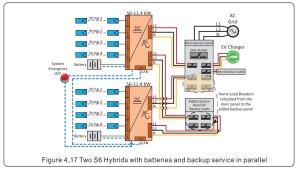chess-equality
Solar Enthusiast
- Joined
- May 21, 2022
- Messages
- 500
If I have multiple Inverters in parallel, this implies I need a lot of DC/battery amperage. And if I have multiple batteries in parallel, this implies each battery BMS will be handling fraction of that amperage which is nice.
Assume BMS are configured to limit 150A each.
Assume at night all inverters combined were drawing 300A from the battery bank.
One by one the batteries fell below undervoltage thresholds and starts disconnecting. Last battery will experience full 300A load will disconnect overcurrent threshold.
I have seen Andy torture tested a JK bms with 200A load and after a preset duration it cuts off but one of the transistors popped. I guess the transistors did not shut off perfectly at the same time so much so one of them took the full blunt of the 200A alone and died.
Having said that, is it more dangerous for the BMS to have parallel batteries to parallel inverters?
I will let the inverter or the breakers disconnect early rather than giving this decision to any of the BMSes, given that even at ideal conditions, BMSes can be quite finicky. I would rather deal with one or few (inverters / breakers) than many (battery BMSes) that you can't access quite easily.
And I would never max out what the specs say. I'm running two inverter systems (3kw and 3.5kw, respectively) as UPS, each for a 30A (220v) AC outlet, but I appropriate my load to use only half (1.5kw) max of each. Each also has a PDU-style power strip with a breaker and watt meter for monitoring.
Using only half may be quite a waste, but it's just me.



